Annapurna Base Camp Trek
- 13 Breakfast
- 11 Lunch
- 11 Dinner
- Hotels in Kathmandu and Pokhara
- Simple lodge in Trekking
- Sightseeing
- Scenic Drive/flight
- Trekking

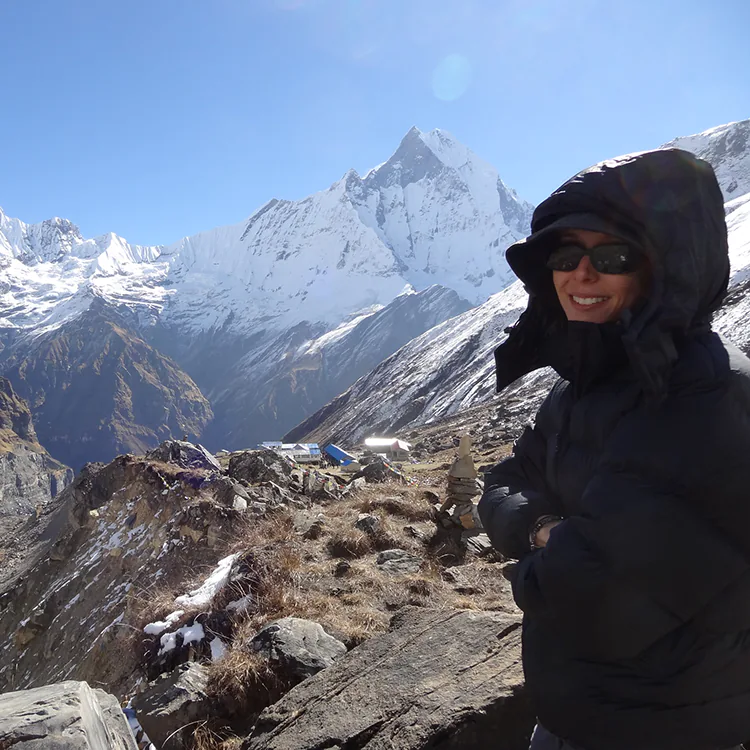
Annapurna Base Camp Trek, an iconic trail in Nepal, is ready for you. It is a unique combination of adventure and natural beauty in its perfect state. The trek takes you through various landscapes, ranging from green forests to rocky mountains, and has many challenges. It ensures that all your senses are involved.
In addition to being one of the most popular trekkers worldwide, the Annapurna Base Camp Trek also attracts people who want to enjoy interesting panoramic views over different snow-capped peaks (Annapurna I and Machapuchare). Hospitable villages along the route allow trekkers to meet Gurung and Magar communities and better understand their cultures.
What makes the Annapurna Base Camp Trek genuinely remarkable is its combination of scenic beauty, cultural richness, and a moderate level of adventure. Every day on this trek highlights the natural wonders of the Annapurna region, from tranquil rivers to majestic mountain vistas, creating unforgettable moments.
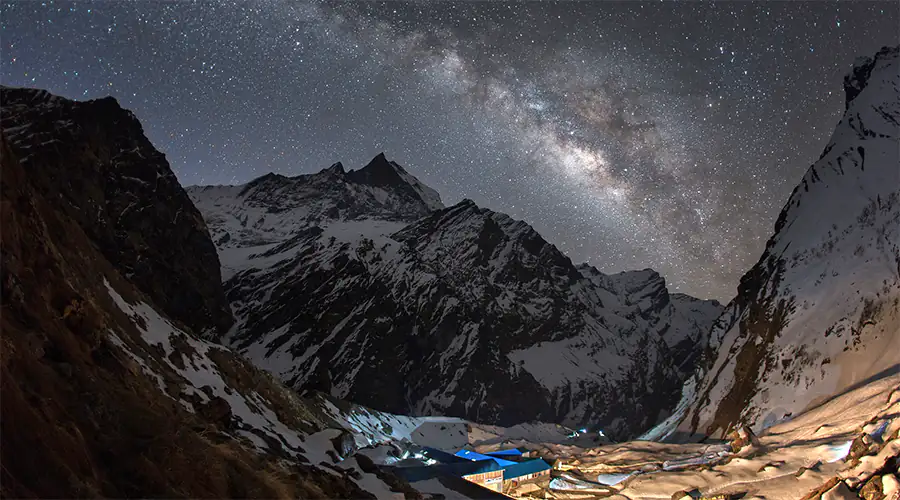
Milky Way Galaxy over MBC
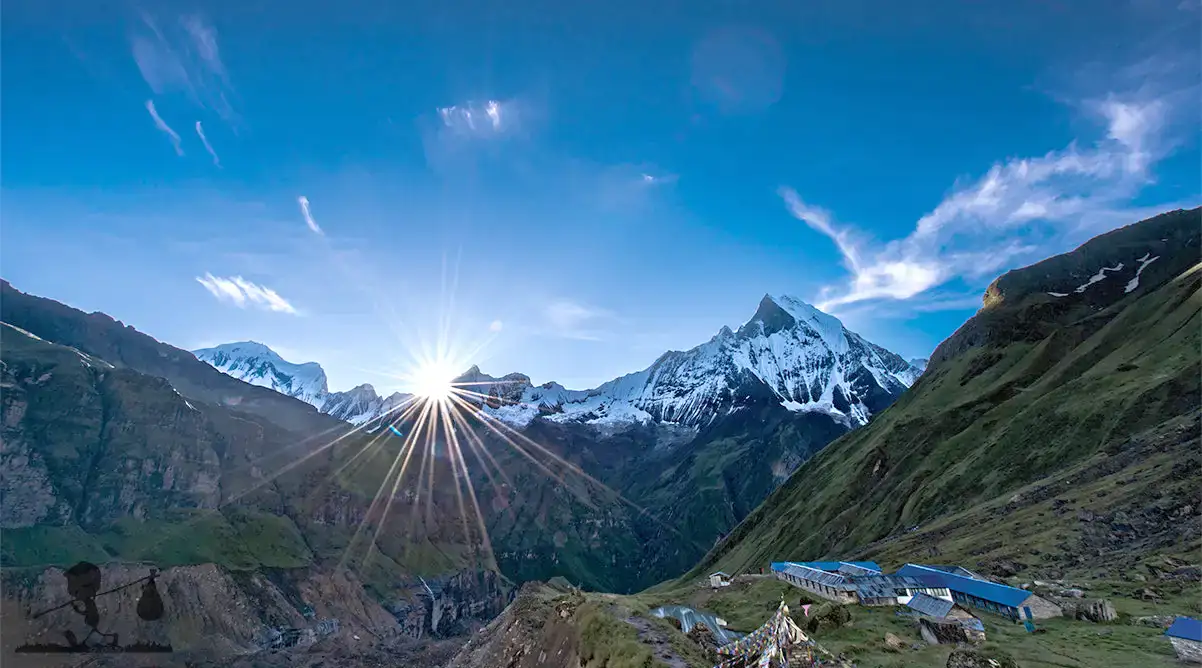
Sunstar at ABC
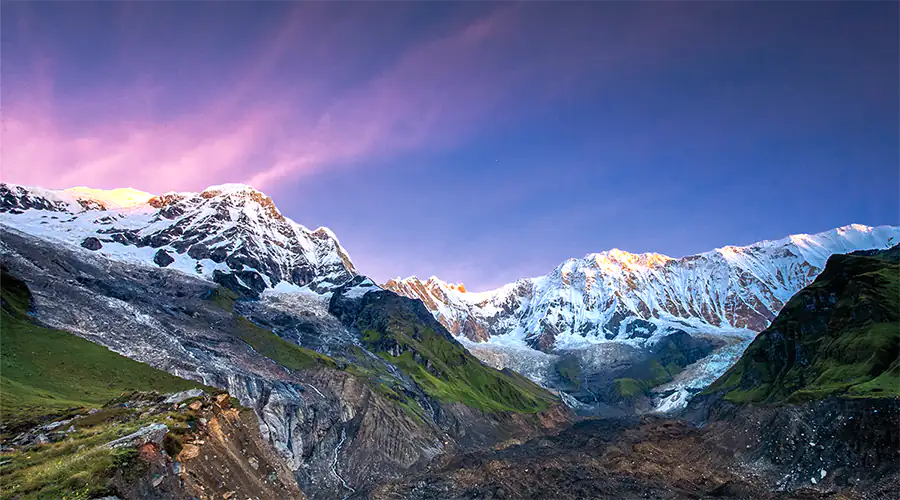
Annapurna Base Camp

Colors of Faith
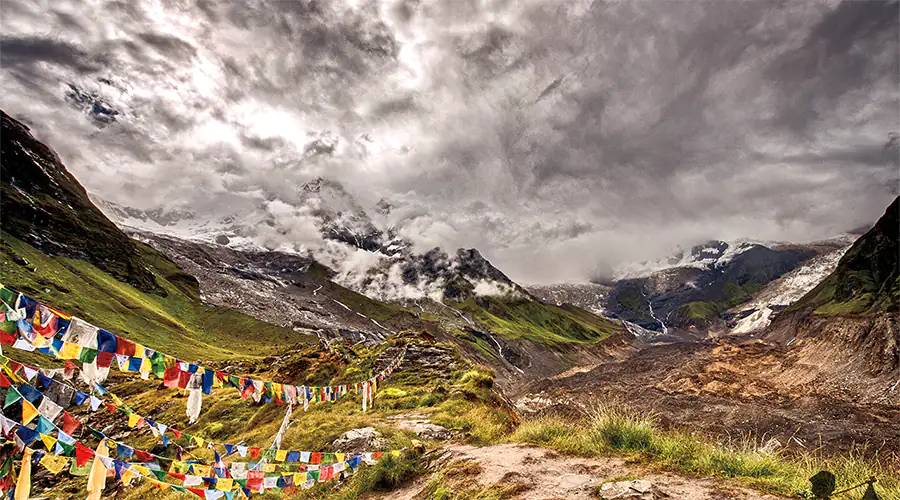
Lung-Ta
When you land at Tribhuvan International Airport, one of our representatives will receive you warmly and take you to your hotel. After checking in, you can take a relaxed walk through the nearby streets, where you’ll catch your first glimpses of Kathmandu’s vibrant culture and history. This short exploration lets you soak in the lively atmosphere of Nepal’s capital before you start your trek.
In the evening, we will hold a brief trip meeting where you’ll meet your guide for the Annapurna Base Camp Trek. Your guide will review essential details, answer any questions, and explain the itinerary clearly, ensuring you’re ready and well-informed for the trek.
Accommodation: The Everest Hotel
Meals: Not Included
We set off for Pokhara early in the morning, driving through the winding roads of the Nadhunga hills and then onto the plains of Dhading. Following the mighty Trishuli River, we make our way to Mugling. We take a break for lunch at Malekhu, a well-known spot famous for its tasty fish dishes, offering a delightful pause during the drive.
After we have crossed the Trishuli River at its intersection with the Marshyangdi River, we keep following the charming banks of the Marshyangdi River. By around 14:00, we will reach Pokhara, where our guide will assist you in checking into your hotel comfortably. If you feel like it, you can take a soothing boat ride across the still waters of Fewa Lake.
Lakeside, quite famous among foreign tourists, offers dinner at lively restaurants in the evening. This evening is perfect for resting and preparing for the upcoming Annapurna Base Camp Trek.
Accommodation: Kuti Resort or similar
Meal: Breakfast
Today, your trek begins. After enjoying breakfast in Pokhara, you will drive to Nayapul, a small village along the Modi River. The driving distance is around one hour and thirty minutes, which usually affords us beautiful scenery en route. Once we get there, our trek will kick off by walking through Nayapul’s stunning landscape.
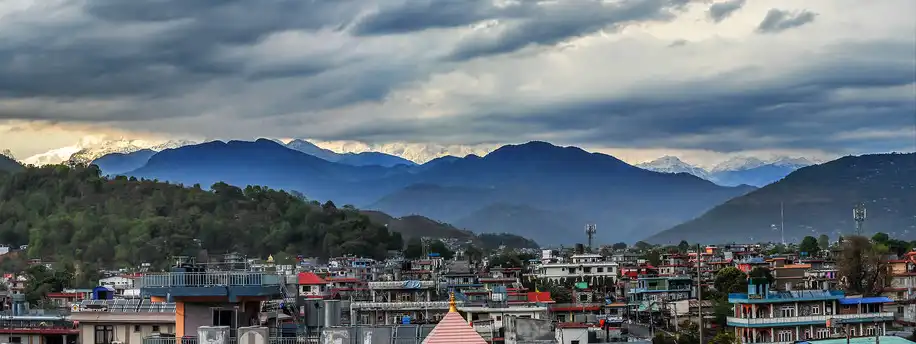
Our first stop is at Birethanti, where we check our permits before continuing towards Ghandruk. This picturesque village, home to the Gurung community, captivates visitors with its neatly arranged stone houses topped with snow-covered roofs.
The beauty of Ghandruk lies not only in its architecture but also in its peaceful tea garden, located just above the village, where you can pause to take in the serenity.
As the day winds down, you’ll relax on your hotel terrace, watching the sunset over the mountains. The views of Fishtail, Annapurna South, and other towering peaks glowing in the evening light will remind you why the Annapurna Base Camp Trek is such a sought-after experience.
Accommodation: Local Lodge or Teahouse
Meal: Breakfast, Lunch, and Dinner
The hour-long trek from Ghandruk to Kimrungdanda offers breathtaking views. As you walk, the stunning peaks of Annapurna South, Machhapuchhre, Himchuli, and Gangapurna unfold before you, making every step a visual delight. The trail is peaceful and inspiring, offering a genuine connection with the Himalayan landscape.
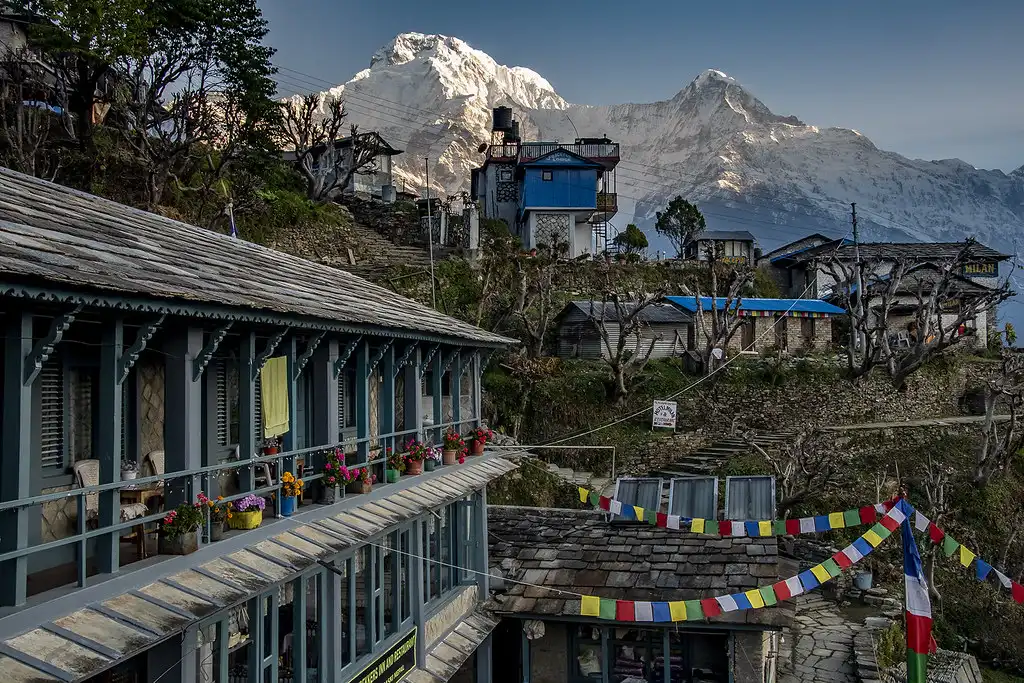
Once you reach Kimrungdanda, the road steepens to Kimrong Khola, a scenic river crossing. The descent offers flexibility, transitioning from an open hillside to a more enclosed and peaceful riverside setting. The calm waters of the Kimrong Khola provide a brief respite before the next challenging section of the route.
After crossing the river, the path climbs steeply towards Chere Staff. This climb can be demanding, but the promise of even more spectacular views at the top keeps you going. The climb is rewarding, and once you reach Chere Danda, you will see the Annapurna range all around you.
The road descends from Chere Danda, but this time, it is a gentle trek to Chhomrong. This small village sits peacefully on the majestic lap of Annapurna, providing a welcome sight after a day of trekking. Chhomrong is known for its traditional beauty and is the gateway to the Annapurna camping trek, making it an ideal place to relax and immerse yourself in the majestic mountains.
Accommodation: Local Lodge or Teahouse
Meal: Breakfast, Lunch, and Dinner
We enjoy an early breakfast at our lodge and begin the day by descending the famous 2,500-stone steps that lead to Chhomrong Khola. Though the steep path requires careful steps, the stunning mountain views and lush green hills make the walk enjoyable. After reaching the river, we cross a small bridge and prepare for the uphill climb.
Trekking from Chhomrong Khola to Sinuwa is both challenging and rewarding. As we gain altitude, the air grows more fantastic, and the views become even more breathtaking.
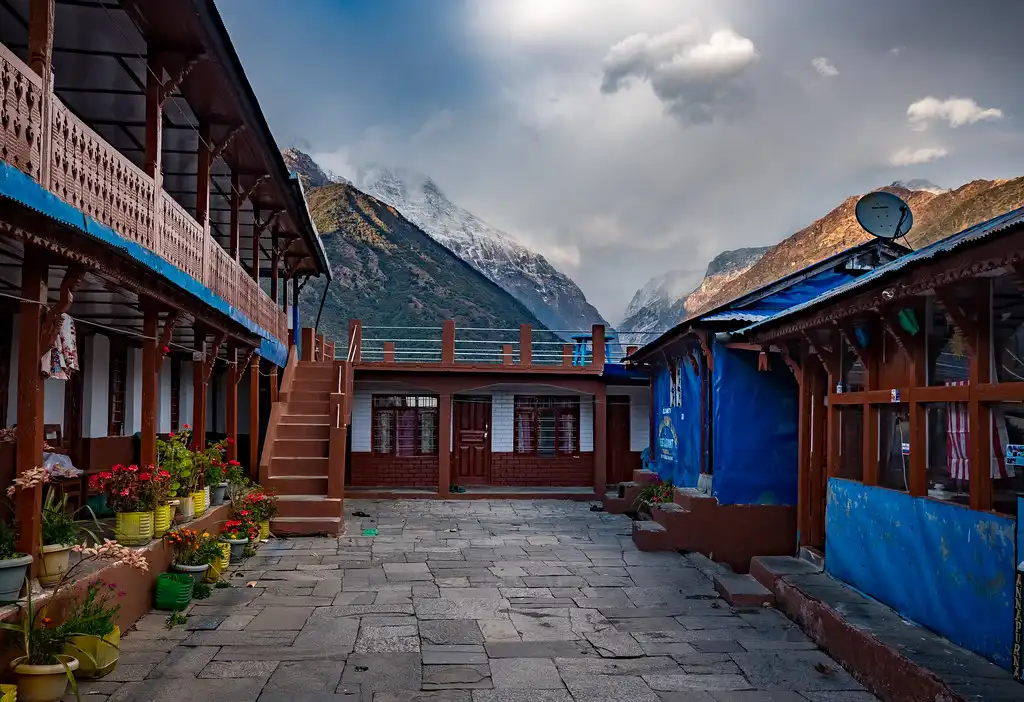
When we arrive in Sinuwa, we find ourselves surrounded by a peaceful forest, where the sound of birds singing adds to the calmness of the surroundings. Walking in the forest is like being in a peaceful Himalayan retreat.
Leaving Sinuwa, we continue through the forest until we reach the tranquil spot of Kuldihar. The trail becomes more accessible from here, with a gentle downhill walk leading us to Bamboo. The pleasant descent brings us to Bamboo, where we pause for lunch and refuel before continuing to the Annapurna Base Camp Trek.
Accommodation: Local Lodge or Teahouse
Meal: Breakfast, Lunch, and Dinner
Today’s trek is challenging as we navigate the dense, damp bamboo forest. The trail pushes us through steep sections that test our stamina. However, reaching the Himalayan Hotel rewards our efforts. The forest opens here, revealing a stunning view of the glacier-fed river below that instantly revitalizes us after the challenging climb.
After leaving the Himalayan Hotel, we walk through a wooded path. Birds chirp, creating peace, while the gentle breeze cools us off. On this hike section, we enjoy quiet moments among towering trees as we move toward Hinku Cave.
From Hinku Cave, the trail goes downhill towards the river, which sounds like flowing water. However, this only lasts a while before we start another steep climb towards Deurali. Although strenuous, it provides some of the most beautiful views on this trek. In this semi-deserted area, you can enjoy unobstructed, raw scenery characterized by a rugged valley and a distant stream.
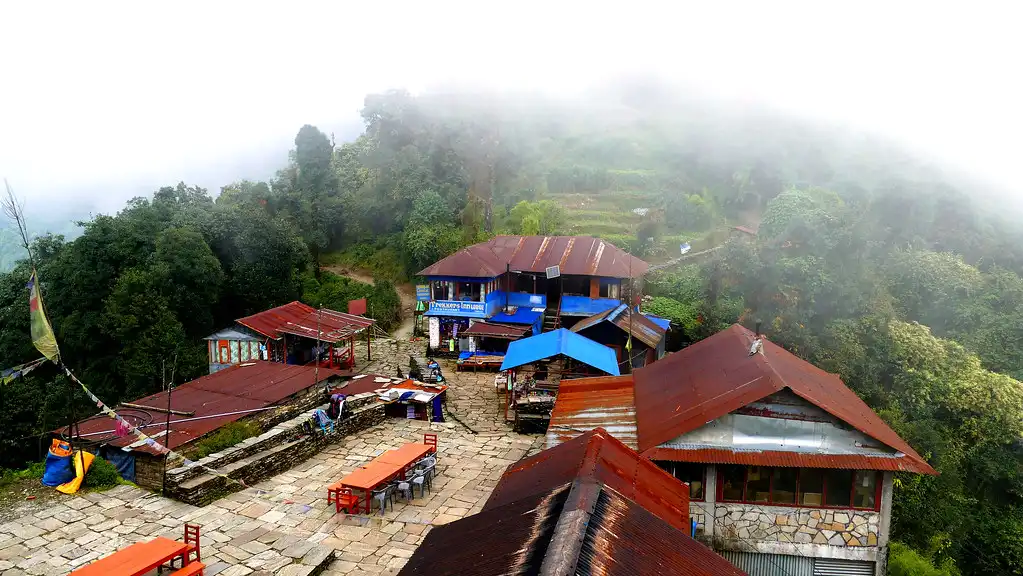
As we near Deurali, the landscape shifts into a picturesque setting. The gushing river and rocky cliffs surround us while small waterfalls trickle down the rocks, adding to the scene’s charm. The flowing water, rocky terrain, and distant mountain peaks create a breathtaking view, making this one of the most unforgettable parts of the Annapurna Base Camp Trek.
Accommodation: Local Lodge or Teahouse
Meal: Breakfast, Lunch, and Dinner
Today’s Annapurna Base, Camp Trek segment is as challenging as it is rewarding. Your journey begins with a walk through a river bed and a steep climb on rocky terrains. The path from Bagar to Machhapuchhre Base Camp tests your endurance, but the reward is immense. When you reach Machhapuchhre Base Camp, the stunning mountain vistas greet you.
There are out-of-this-world views from Machhapuchhre Base Camp. You will be able to look at big mounds like Mt. Machhapuchhre, Himchuli, Annapurna South, Annapurna I, Annapurna III, Gandharvachuli, and Gangapurna, which are all magnificent peaks.
The background of these mountains is simply jaw-dropping. This sensation is like being in paradise as you trek towards Annapurna Base Camp, with the imposing south face of the mighty Annapurna mountain rising prominently before you.
Upon arrival at Annapurna Base Camp, you find yourself surrounded by a 360-degree view of towering peaks—an experience often referred to as being in ‘the sanctuary.’ This area is renowned for offering one of the most awe-inspiring panoramas in the region. Here, the views of Machhapuchhre, Annapurna South, Annapurna I, Himchuli, and other significant peaks envelop you, creating a profound sense of achievement and awe.
This segment of the Annapurna Base Camp Trek brings you into intimate proximity with the natural grandeur of the Himalayas. The sanctuary is a highlight of the trek and a moment of profound connection with the mountains, providing trekkers with memories that will last a lifetime.
Accommodation: Local Lodge or Teahouse
Meal: Breakfast, Lunch, and Dinner
When we got there, the Annapurna Base Camp was a delightful place. Since we have to return to Bamboo, we will retrace our steps. This trek section is more straightforward, primarily downhill, allowing for a slow and unbothered pace. As such, the descent is an opportunity to think about the beautiful things that happened at base camp.
It also gives us something for the eyes to feast on as we walk downhill. The route winds through dense forests with green leaves and past still water, making it quite serene. It is ideal for appreciating those times during your walk when silence reigns supreme as you take in all the different colors nature has to offer amidst its surrounding landscapes.
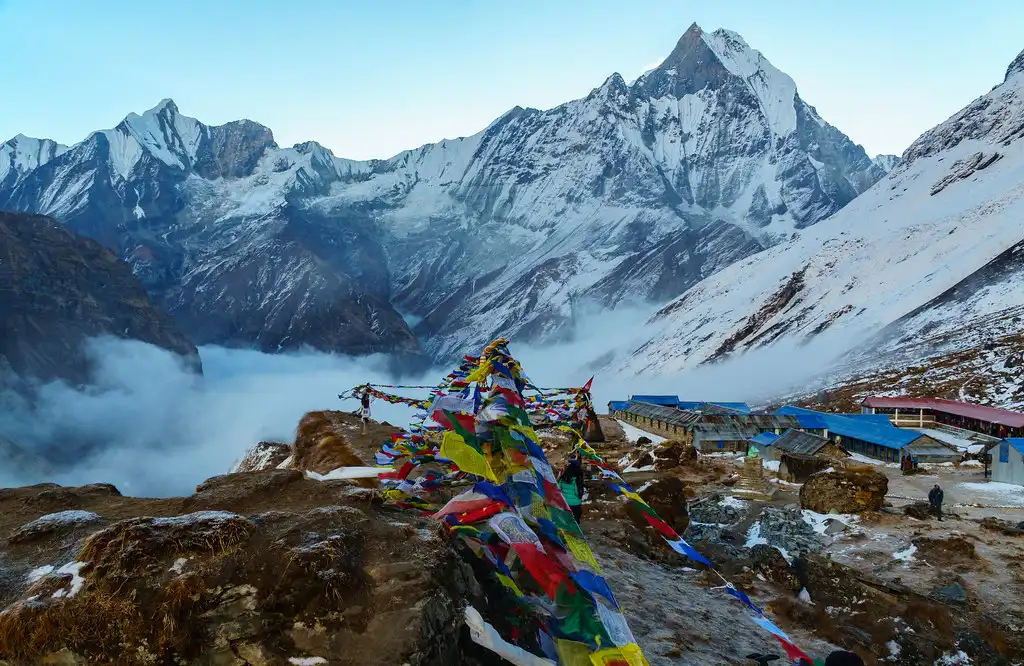
We continue to enjoy the beautiful landscapes that characterize the Annapurna region. The panoramic views of the valleys and distant mountains accompany us as we return to Bamboo. This leg of the trek offers physical ease and a chance to absorb the serene environment, making every step a memorable part of our adventure.
Accommodation: Local Lodge or Teahouse
Meal: Breakfast, Lunch, and Dinner
From Bamboo, the trail on the Annapurna Base Camp Trek takes a slight ascent to Kuldighar, offering a gentle challenge after the more relaxed descent of the previous day. The path then leads downhill to Chhomrong Khola, a serene spot that provides a picturesque setting for a brief rest before the next climb.
The journey continues with an ascent up the stone steps to Chhomrong. This part of the trek tests your endurance but rewards you with stunning views and the satisfaction of conquering the climb. Chhomrong is a crucial junction on the Annapurna Base Camp Trek, connecting several paths and offering beautiful views of the surrounding mountains.
After leaving Chhomrong, the trail descends to Jhinu Danda, known for its welcoming hot springs. Just a 20-minute walk from the village, these hot springs provide the perfect opportunity to soothe your aching muscles.
Immersing yourself in the warm waters amidst the cool mountain air is a rejuvenating experience, making this stop a highlight for many trekkers on the Annapurna Base Camp Trek.
Accommodation: Local Lodge or Teahouse
Meal: Breakfast, Lunch, and Dinner
This is the best trekking day in the Annapurna Base Camp Trek. You can skip this part by taking a jeep direct to Pokhara, but we highly recommend you give one full day for this part. After breakfast at Jhinu, we start our trek with some descends at the beginning and more climbing to arrive at Pothana.
We will have lunch in Tolka and continue our trek. The trail today is more beautiful, with the views of scattered villages of Ghandruk and Modi Khola. You can see beautiful cascade farmland, Mount Annapurna South, Mount Hiunchuli, and Landruk Village – inhabitants of ethnic Gurung People. Pothana lies on the top of the rhododendron forest, which is the viewpoint for the different mountains like Annapurna Himalaya Range and Manaslu in the far distance.
Accommodation: Local Lodge or Teahouse
Meal: Breakfast, Lunch, and Dinner
Today marks the final day of walking on our Annapurna Base Camp Trek. The trek to Nayapul is a stroll, allowing you to savor the mesmerizing hill landscapes one last time as you transition from the mountainous regions. The serene walk provides ample opportunity to reflect on the incredible journey and capture a few final scenic photos.
Upon reaching Nayapul, our jeep will be ready and waiting to transport you to Pokhara. The drive depends on the road conditions but typically offers a smooth transition from the quiet trails to the lively city atmosphere. Arriving in Pokhara, you can relax and revel in the comfort and amenities of the city, celebrating the completion of your trekking adventure.
Accommodation: Kuti Resort or similar
Meal: Breakfast, Lunch, and Dinner
You take an early bus to Pokhara, traveling along winding roads that offer scenic views of Nepal’s rural heartland. As you go, this comfortable trip lets you glimpse some daily happenings in the countryside and witness beautiful landscapes.
It would help if you arrived in Kathmandu around 3 p.m. when our guide will meet you at the bus station to take you to your hotel. We facilitate this transition without any hustle for your smooth settling in.
After resting at our hotel, the evening can be an excellent opportunity for some last-minute shopping. Finding unique gifts or tokens for your friends and family in Kathmandu’s markets and boutiques is easy. You could explore the vibrant streets, where vendors sell traditional Nepali crafts, textiles, and other local specialties, providing an unforgettable ending to your trek.
Accommodation: The Everest Hotel
Meals: Breakfast, Lunch, and Dinner
In Kathmandu’s UNESCO World Heritage sites, your guide will be Peregrine Treks’ tour guide, who will give you an insight into the history and culture of the city through their immersive tour. Swayambhunath, or Monkey Temple, sits atop a hill and offers breathtaking city views.
Locals widely know it by this name. The calmness at this place is in sharp contrast with the city rush below. A visit to Bouddhanath, one of the world’s largest stupas, will follow next, where chanting monks and devout Buddhists create a serene atmosphere conducive to contemplation.
The journey then leads to Pashupatinath, a revered Hindu temple along the Bagmati River. This temple acts as a spiritual haven for Hindu worshippers and is renowned for its solemn yet captivating cremation rituals, which are visible to the public.
Your historical exploration culminates at Kathmandu Durbar Square, showcasing Nepal’s splendid architectural and cultural heritage. It features palaces, courtyards, and temples from the Malla and Shah eras, which narrate the city’s illustrious history.
Concluding your trekking, Peregrine Treks will organize a farewell dinner at an old-style Nepali inn with a cultural exhibition. This festive night embodies the Nepalese lifestyle through attentive welcome and exquisitely prepared traditional meal items.
The artistic showcase, showcasing dance and music of the various ethnic groups in Nepal serves as a culmination of this intensive tour you have taken through the ancient places of Kathmandu.
Accommodation: The Everest Hotel
Meals: Breakfast
Last day in Nepal! Our representative will drop you at the airport approximately three hours before your flight. I hope you will have a lot of good memories from Nepal to take to your country.
Meals: Breakfast
Selecting the optimal time for the Annapurna Base Camp Trek is essential for a safe, enjoyable, and memorable adventure. You can undertake this trek at various times throughout the year, each offering unique weather conditions, landscapes, and challenges. Here’s a detailed exploration of the best periods to embark on this incredible journey.
Spring ranks among the most favored seasons for the Annapurna Base Camp Trek. The weather typically remains stable during this season, featuring mild temperatures and clear skies. The lower areas are not too hot or cold, so it’s suitable for hiking. As you climb to higher altitudes, the temperatures drop yet stay manageable.
This time also coincides with the blooming of rhododendron forests, which drape the landscape in vibrant hues. The season promises breathtaking views of the Annapurna and Dhaulagiri ranges, with the clear skies ensuring excellent visibility of the snow-capped peaks. Trails tend to be busier, as many trekkers seize the opportunity to experience these favorable conditions.
Many often tout autumn as the prime season for the Annapurna Base Camp Trek. Following the monsoon rains, the air turns fresh, and the skies become exceptionally clear, revealing stunning vistas of the surrounding mountains. Daytime temperatures are more relaxed at higher elevations.
The dry trails make trekking both more accessible and safer. Additionally, major Nepalese festivals like Dashain and Tihar occur in autumn, adding a layer of cultural richness to the trekking experience. The perfect combination of superb weather, scenic beauty, and cultural richness makes autumn an ideal time for the trek.
Trekking to Annapurna Base Camp in winter is feasible but presents specific challenges. It gets colder when you climb higher, especially at night. Higher altitudes might experience snowfall, rendering the trails slippery and more challenging to navigate.
Nonetheless, with adequate cold-weather gear and preparation, winter trekking can be immensely rewarding. The trails are less crowded, and the snow-draped landscape offers a unique, serene beauty. Clear winter skies also ensure excellent visibility of the mountain peaks. However, remember that some teahouses may close due to the cold, necessitating careful planning and flexibility.
The monsoon season is generally the least recommended time for the Annapurna Base Camp Trek due to heavy rainfall that makes the trails muddy and slippery, raising the risk of landslides, particularly in the lower regions. Sponges are more prevalent during this time, adding to the trek’s challenges.
However, trekking in the monsoon can still be appealing. The landscape is lush and verdant, with waterfalls at their most spectacular. The paths are quieter, offering a more solitary trekking experience. Clouds and mist may reduce the visibility of the mountains. If you choose to trek during the monsoon, proper gear and thorough preparation are crucial to managing the wet conditions effectively.
Related Article: Best Time for Annapurna Base Camp Trek
The Annapurna Base Camp Trek unfolds along a cherished path, offering breathtaking views of the Himalayas and immersive cultural encounters. Starting in Nayapul and culminating at Annapurna Base Camp, this trek traverses diverse landscapes and quaint villages, showcasing some of Nepal’s most spectacular mountain scenery. Familiarizing yourself with the Annapurna Base Camp Trek route is essential for a well-planned and enriching trekking experience.
The Annapurna Base Camp Trek starts in Nayapul, a small town accessible from Pokhara. It is an ideal starting point for acclimatizing to lower altitudes before venturing into the heart of the Annapurna region. The trek starts along the Modi Khola.
Leaving Nayapul, you’ll first reach Ghorepani, a village renowned for its vibrant rhododendron forests. A morning hike from here to Poon Hill rewards trekkers with a stunning sunrise view across the Annapurna and Dhaulagiri ranges, offering a memorable highlight early in your journey.
The trail from Ghorepani then leads you down to Chomrong, a picturesque Gurung village on a hillside. As a critical stop on the Annapurna Base Camp Trek route, Chomrong offers expansive views of Annapurna South and Machhapuchhre. Beyond Chomrong, the path winds through lush forests and across rivers, with a steady ascent towards higher altitudes.
The challenge intensifies as you near Machhapuchhre Base Camp (MBC), the gateway to Annapurna Base Camp. The steep climb to Machhapuchhre Base Camp (MBC) rewards you with spectacular views of Machhapuchhre, Himchuli, and the Annapurna massif. From MBC, you face a relatively short hike to reach the ultimate destination, Annapurna Base Camp.
At Annapurna Base Camp, towering peaks such as Annapurna I, Annapurna South, and Machhapuchhre encircle you. The Annapurna Base Camp Trek provides a 360-degree panorama of these majestic mountains, ensuring that every step you take on this trek fills you with awe and wonder.
Related Article: Annapurna Base Camp Trek Route
Annapurna Base Camp is a famous hike in Nepal. Understanding the trek’s distance is crucial for proper preparation and pacing. Here’s a comprehensive guide to the distance you’ll cover on this iconic trek.
The Annapurna Base Camp Trek covers an approximate total distance of 110 kilometers (68 miles). The hike takes 7 to 12 days, depending on the path you take and how fast you walk. The trek ascends to 4,130 meters (13,549 feet) at Annapurna Base Camp, so carefully planning your daily distances is crucial for proper acclimatization.
The daily walking distances on the Annapurna Base Camp Trek vary depending on the itinerary. Here’s a general breakdown:
This distance of trekking to Annapurna Base Camp varies at an individual pace and requires extra site visits. Some trekkers may also opt to go for side trips, such as going to Jhinu Danda hot springs or extending the trek to cover Poon Hill sunrise views. Thus, these detours can contribute several kilometers to the total trekking distance.
Pacing is also a critical factor. Some trekkers prefer shorter daily walks to allow more rest and acclimatization, while others might push for longer days on the trail. Adjusting your daily distances based on your feelings and acclimatization needs is essential for a safe and enjoyable trek.
Related Article: Annapurna Base Camp Trek Distance
Trekking up to Annapurna Base Camp is characterized by astonishing landscapes and physical challenges. This guide should help you understand the problematic trekking path and adequately prepare for your next trek.
The Annapurna Base Camp Trek is moderately challenging and demands good physical fitness and experience. It spans 7 to 12 days, covers around 110 kilometers (68 miles), and reaches its apex at Annapurna Base Camp, which sits at 4,130 meters (13,549 feet). The high altitude significantly influences the trek’s difficulty, potentially leading to altitude sickness without proper acclimatization.
The Annapurna Base Camp Trek is moderately complex and requires reasonable fitness and previous experience. It takes seven to twelve days and covers approximately 110 kilometers (68 miles), with the Annapurna Base Camp at 4,130 meters (13,549 feet). The high altitude primarily contributes to the difficulty of this trek, potentially causing altitude sickness if you do not acclimate adequately.
The difficulty of the Annapurna Base Camp Trek stems from several key factors:
Adequate preparation for the Annapurna Base Camp Trek involves both physical training and strategic planning:
Related Article: Annapurna Base Camp Trek Difficulty
A simplified Annapurna Base Camp trek map offers a clear visual guide that helps trekkers navigate the route. The map highlights vital locations such as Nayapul, where the trek begins, along with popular stops like Ghorepani, Poon Hill, and the village of Chomrong. It also marks higher-altitude spots, including Machhapuchhre Base Camp (MBC) and Annapurna Base Camp (ABC), ensuring you can easily follow the main points along the trail.
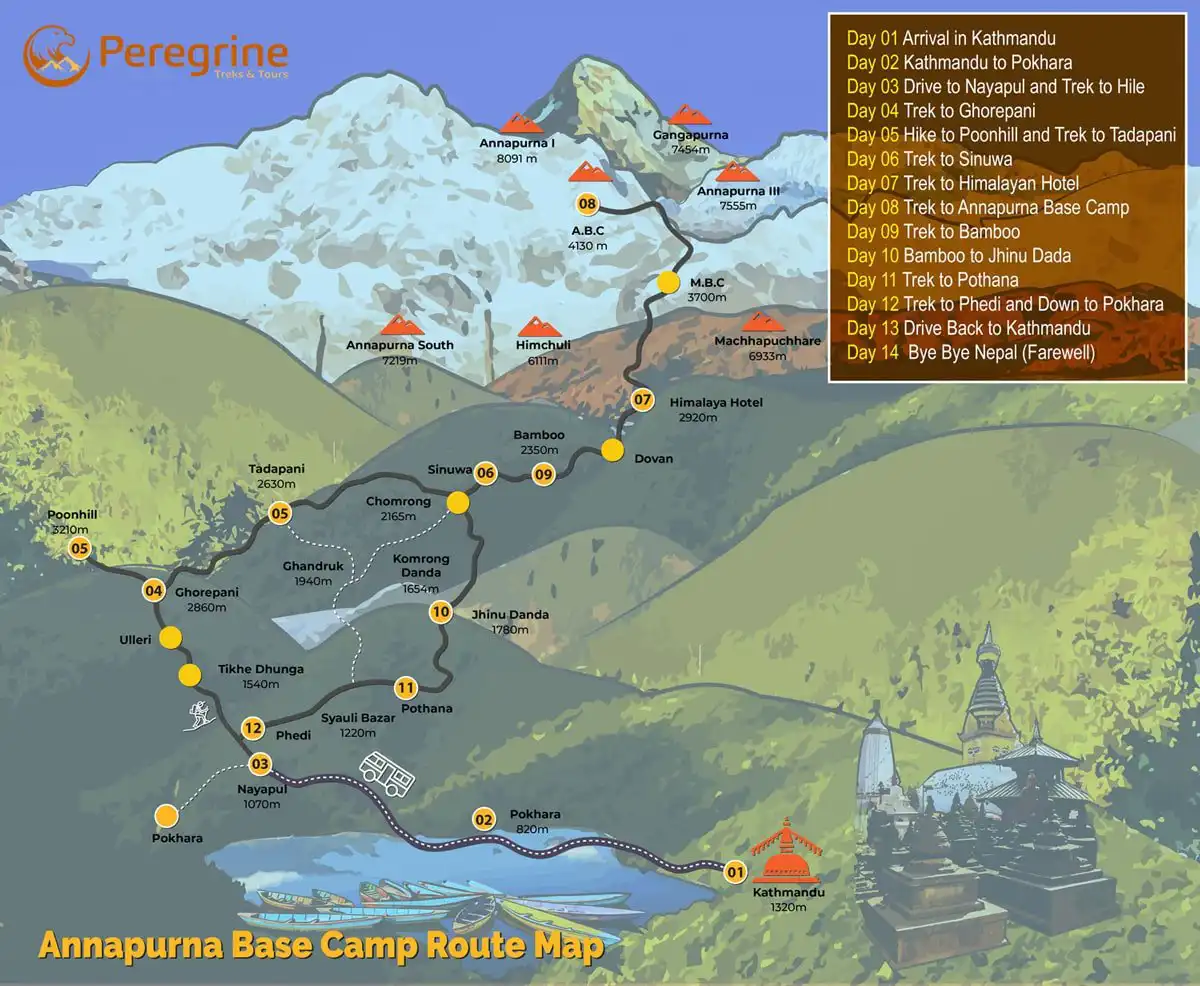
The Annapurna Base Camp trek map allows you to visualize the route and organize your daily trekking plans more effectively. The map also outlines essential features like rivers, forested sections, and steep climbs, helping you prepare for the terrain ahead. Carrying this map will give you confidence and direction, enhancing your overall trekking experience.
The Annapurna Base Camp Trek offers an incredible experience, but understanding the costs can help you plan effectively. Here is a detailed breakdown of the estimated expenses to give you a clear idea of what to expect on this trek.
To trek in the Annapurna region, you will need:
Hiring a guide or porter can significantly improve your trekking experience. A guide typically charges between USD 25 to 35 per day, while a porter usually costs around USD 15 to 20 per day. These rates may vary depending on the provider and the time of year you choose to trek.
Accommodation along the Annapurna Base Camp trek route is mainly in teahouses. Costs range from USD 5 to 10 per night, depending on the altitude and amenities. These teahouses provide basic lodging, food, and sometimes hot showers.
Expect to spend between USD 3 to 5 per meal in teahouses. Daily food costs typically range from USD 15 to 30, depending on your appetite and dining choices. Traditional Nepali meals like Dal Bhat are commonly available.
Transportation to and from the starting point of the trek can vary:
Other expenses include gear rentals, tipping guides and porters, and personal items like water and snacks. Gear rental for items like sleeping bags and down jackets can range from USD 1 to 2 per day for additional costs such as souvenirs, snacks, and occasional luxuries like hot showers.
Related Article: Annapurna Base Camp Trek Cost
You can complete the Annapurna Base Camp Trek in 7 to 12 days, depending on your pace, itinerary, and acclimatization needs.
The trek spans approximately 110 kilometers (68 miles) from Nayapul to Annapurna Base Camp, which sits at 4,130 meters (13,549 feet). Some trekkers may opt for shorter or longer variations depending on fitness levels and time availability.
The Annapurna Base Camp Trek is moderately challenging. The trek involves steep ascents and descents across varied terrain, such as stone steps and rugged paths.
The altitude adds to the difficulty, with Annapurna Base Camp at over 4,000 meters. Proper acclimatization, physical fitness, and mental readiness are essential for completing the trek.
The Annapurna Base Camp Trek costs between USD 1,100 and 1,400, depending on the season, whether you choose a guided or independent trek, and any additional services.
This estimate includes costs for permits, guide and porter fees, accommodation, meals, and transportation. Be sure to account for gear rental and personal expenses in your budget.
The Annapurna Base Camp Trek is generally less demanding than the Everest Base Camp trek regarding altitude, as Everest Base Camp sits at 5,364 meters (17,598 feet).
However, both treks involve steep and challenging terrain, requiring good physical fitness. Annapurna may be more accessible due to its shorter duration and lower altitudes.
Indeed, aspiring trekkers can prepare appropriately for the Annapurna Base Camp Trek. Developing stamina through cardiovascular exercises, strength training, and extended walking is crucial before attempting this trip.
In addition, it would be helpful if you divided your walking in time to allow acclimatization and also take on the services of a guide, thus improving the chances of success.
The ideal seasons for the Annapurna Base Camp Trek are spring (March to May) and autumn (September to November). These months provide stable weather, clear skies, and moderate temperatures, which make trekking conditions ideal. Spring offers blooming rhododendrons, while autumn provides crisp air and clear mountain views.
Anyone interested in breathtaking mountain scenery, cultural experiences, and endeavors should consider the Annapurna Base Camp Trek.
The trek passes through different landscapes, ranging from thick forests to icy glaciers, bringing forth the marvelous sites of Annapurna I and Machhapuchhre, among other peaks of the Himalayas. After reaching the Annapurna Base Camp, one has indeed achieved something remarkable.
Trekking the Annapurna Base Camp is generally safe if you take the necessary precautions. Hiring an experienced guide, following a well-planned itinerary, and allowing for acclimatization reduce risks.
However, be cautious of altitude sickness and unpredictable weather, especially at higher elevations. Bringing a first aid kit and staying hydrated are also crucial safety measures.
Layered clothing is essential for adapting to varying temperatures during the Annapurna Base Camp Trek. Wear moisture-wicking base layers, insulating mid-layers like fleece or down jackets, and waterproof outer layers.
Trekking boots, warm gloves, hats, and a scarf or buff are also necessary. Packing quick-dry shirts, trekking pants, and thermal underwear ensures you stay comfortable throughout the trek.

Based on 4 Reviews

I’ve been on several expeditions, but this was the finest one. I recall how beautiful it was to trek via Poonhill and descend to the Ghorepani. Along with the breathtaking mountain environment, there were waterfalls on the trail. The locals were kind and inviting. I still remember one of the locals asking if we could stay in their home.
Furthermore, the trek to the peak of Annapurna Base Camp was exhilarating. My heart has a particular place in it for the breathtaking panorama of the Annapurna region. Overall, this expedition with Peregrine Treks and Tours was fantastic.

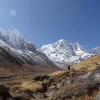
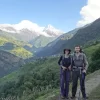
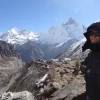

Excellent






We attempted the Annapurna Base Camp Trek during the spring season, and it was the most spectacular from beginning to end. I’d say that during the expedition, the Peregrine offered some of the most outstanding services. This was my first visit to Nepal, and I had no idea that trekking to Annapurna Base Camp could be fantastic. The views from the teahouses were breathtaking. Everything about this was great, from rhododendrons to the incredible wildlife of the Annapurna Conservation area. Although I should have brought wollen garments because it was chilly at such a high altitude, a staff member could fetch some for me, making the trek more pleasurable.
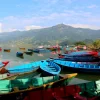
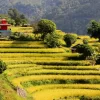

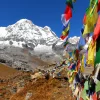

Excellent






The incredible bundle of natural components from the Annapurna Region elevated the expedition to the next level. I got a historical sense of the Gurung People’s small communities. It was interesting to observe the usual dwellings constructed of wood and mud. The stable terrains brushing the clouds in Annapurna and Dhaulagiri’s lap were stunning. Furthermore, I can picture myself trekking with the yak and mules from Chhomrong to Macchapuchre Base Camp. It was beautiful to see the waterfalls and the spectacular surrounding landscape. I’ll return to Nepal again to experience this excellent Annapurna Base Camp Trek.

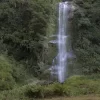
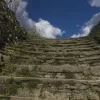
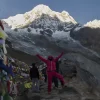

Very Good






With Peregrine Trek and Tours, the excursion was fantastic. Our appreciation to the entire crew for contributing to the success of our Annapurna Base Camp Trek. It was remarkable how much time I spent in teahouses. It was my dream come true to stay in a Nepali teahouse, as I had always wanted to. Although it wasn’t comfortable, I could picture enjoying the beautiful landscape beyond the window. Enjoying the chilly weather and the unique Nepali cuisine was beautiful. The porter and guide had the same qualities of generosity and modesty. Overall, the expedition was beautiful, and I would encourage everyone to do a once-in-a-lifetime tour with Peregrine to explore Annapurna.
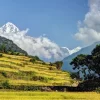
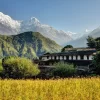
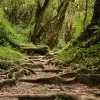
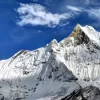

Very Good





